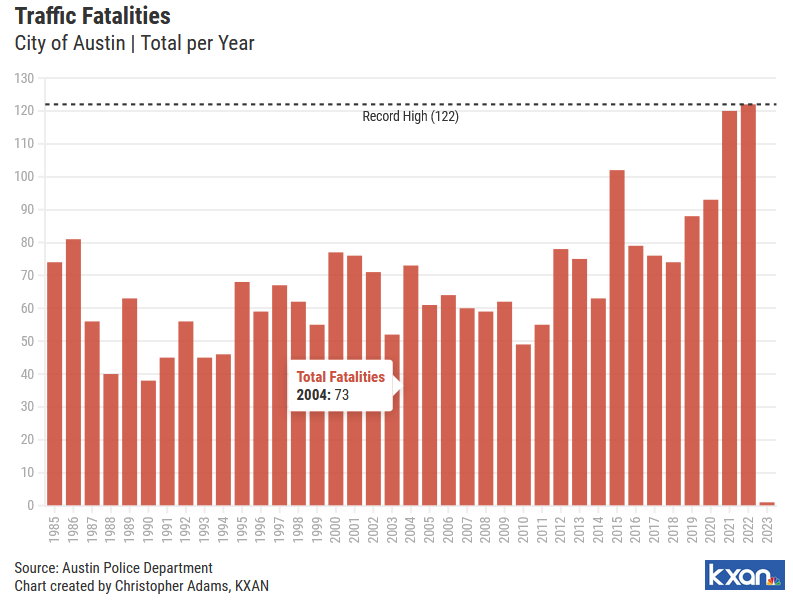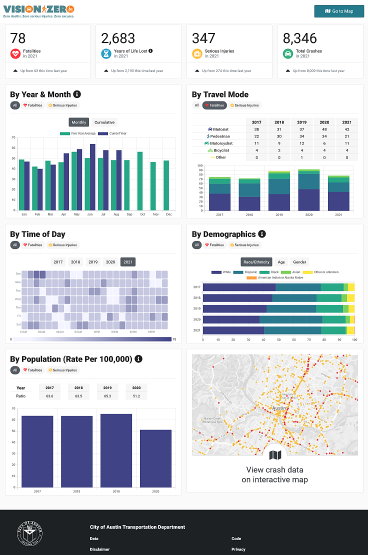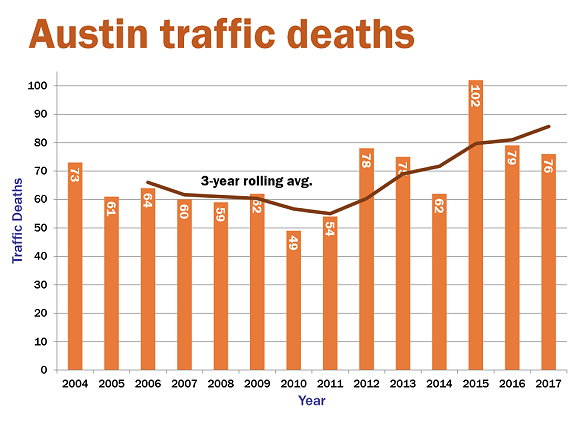City of Austin testing new tech to reduce pedestrian deaths
AUSTIN, Texas – The City of Austin is testing a new technology that could reduce the number of auto-pedestrian crashes. The city along with Siemens and TAPCO launched a pilot for a Pedestrian Crosswalk Warning System in East Austin on Rosewood Avenue at the intersection of Angelina and Navasota streets. When someone pushes the crosswalk button, it sends an alert to all nearby cars capable of receiving the wireless alert. “Newer vehicles right now do have a level of connectivity. But most vehicles at this point don’t have the capability to talk to infrastructure but that’s changing. Volkswagen in Europe is using this technology already. More manufacturers here domestically are going to be producing it,” said Joseph McKenzie, ATD Smart Mobility Office. City officials hope to take what would normally be a distraction, such as your cell phone, and use it as an alert system. Companies are already testing the tech on smart phones. “When those vehicles start coming off the assembly line being connected, Austin will be ahead of the curve knowing how to deploy the technology. Not a lot of transportation DOT’s are that progressive to be looking at this stuff early,” said Mike Long, manager of product management at TAPCO.
DATA: Texas nears 21-year mark of daily traffic fatalities
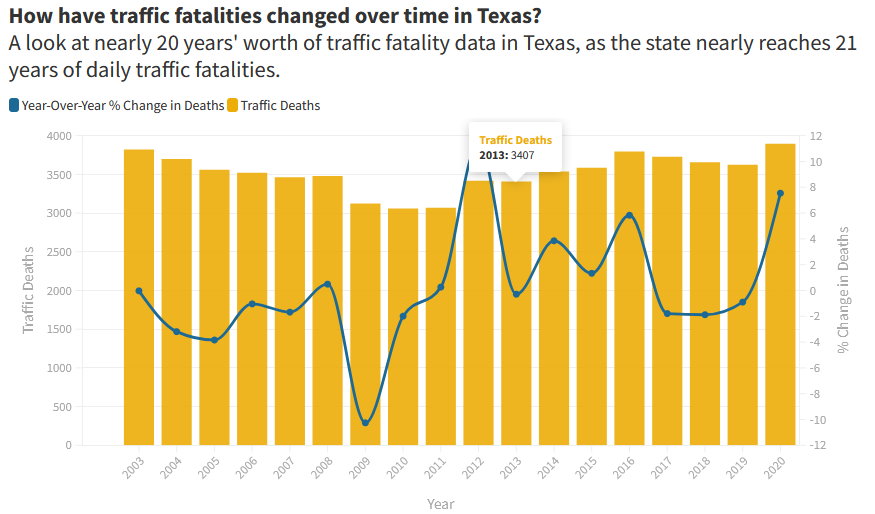 November 2, 2021 — AUSTIN (KXAN) — This weekend marks an unwelcomed and tragic milestone for Texas motorists as the state reaches 21 years of daily traffic fatalities on Nov. 7. For more than two decades, Texas transportation officials have worked on policy initiatives and grassroots campaigns aimed at addressing continued traffic fatalities. Currently, Texas Department of Transportation officials estimate an average of 10 people die each day in vehicle-related accidents. In 2020, 3,896 people died on Texas roadways as a result of traffic-related incidents. That figure translates to a 7.54% jump in traffic fatalities when compared to 2019 levels, even with the coronavirus pandemic’s impact on 2020 traffic levels. “Last year, the top two contributing factors in fatal crashes were speeding and driving under the influence. Those are two factors that we can do something about,” he said. “We cannot engineer our way out have this problem. We cannot engineer our way to zero deaths.” According to TxDOT data, a combined 63,434 lives have been lost in Texas roadway accidents between 2003 and 2020. Since 2000 — the year the state began its daily fatalities streak — that number translates to more than 70,000, officials said. TxDOT developed the #EndTheStreakTX social media campaign as a means of providing drivers and their loved ones safety tips on how to drive distraction-free and assist in minimizing those risks.
November 2, 2021 — AUSTIN (KXAN) — This weekend marks an unwelcomed and tragic milestone for Texas motorists as the state reaches 21 years of daily traffic fatalities on Nov. 7. For more than two decades, Texas transportation officials have worked on policy initiatives and grassroots campaigns aimed at addressing continued traffic fatalities. Currently, Texas Department of Transportation officials estimate an average of 10 people die each day in vehicle-related accidents. In 2020, 3,896 people died on Texas roadways as a result of traffic-related incidents. That figure translates to a 7.54% jump in traffic fatalities when compared to 2019 levels, even with the coronavirus pandemic’s impact on 2020 traffic levels. “Last year, the top two contributing factors in fatal crashes were speeding and driving under the influence. Those are two factors that we can do something about,” he said. “We cannot engineer our way out have this problem. We cannot engineer our way to zero deaths.” According to TxDOT data, a combined 63,434 lives have been lost in Texas roadway accidents between 2003 and 2020. Since 2000 — the year the state began its daily fatalities streak — that number translates to more than 70,000, officials said. TxDOT developed the #EndTheStreakTX social media campaign as a means of providing drivers and their loved ones safety tips on how to drive distraction-free and assist in minimizing those risks.
Austin city leaders approve agreement to fund fix for ‘high-crash’ intersection
November 4, 2021 — AUSTIN (KXAN) — Austin city leaders on Thursday approved an agreement for improvements at a “high-crash” intersection in south Austin. The council voted to allow the Austin Transportation Department (ATD) to work with the Texas Department of Transportation (TxDOT) to address issues at South Congress Avenue and Stassney Lane. TxDOT oversees that portion of S. Congress. The project could cost up to $4 million with the funding coming from the 2018 Mobility Bond. The improvements would include repairs to the roadway and sidewalks, new bus stops, and a reconfiguration of the traffic lights. According to city documents, the intersection was identified as a high-crash area based on “a prioritized list developed using comprehensive crash costs and other engineering factors such as crash rates, frequency and patterns.”
TxDOT Ends $600 Million Set-Aside for Road Safety
A signature transportation safety effort may in jeopardy. As the Houston Chronicle reported on Feb. 2, 2021 “Members of the Texas Transportation Commission last week agreed to a spending plan for the Texas Department of Transportation that does not include money set aside specifically for safety projects.” Thanks in part to the efforts of Farm&City, The Texas Transportation Commission had set aside $300 million annually for traffic safety projects. Upon hearing of this plan, Farm&City’s Executive Director Jay Blazek Crossley addressed the Commission, reminding them of the importance of prioritizing traffic safety, and asking them to preserve this funding. The budget won’t be finalized until August, and until then, Farm&City will continue to explore every option to help the Texas Transportation Commission and TxDOT to preserve this crucial safety funding.
CLICK HERE TO READ THE FULL ARTICLE IN THE HOUSTON CHRONICLE
Parents claim restaurant overserved alcohol to their daughter before her death
Dec. 18, 2019 – AUSTIN (KXAN) — Two parents are suing the Texas Chili Parlor in downtown Austin, claiming the restaurant over served alcohol to their daughter before her March 28 death. According to the lawsuit, Douglas and Rebecca Saathoff, say their daughter Jessica was at the venue and was served alcohol despite being visibly intoxicated. The parents say that later, on the night of March 28, Jessica left the Texas Chili Parlor, located at 1409 Lavaca St., and while riding her bicycle, was struck by a vehicle head-on while traveling eastbound on Martin Luther King Boulevard. The Texas Alcoholic Beverage Commission, or TABC, also said it investigated and did not find any violations. The investigation was closed, saying the restaurant did not over serve or over sell to Saathoff.
State Rep. Celia Israel: Traffic deaths are preventable if we take action
 By Celia Israel — Last week marks a grim anniversary in Texas history. Since Nov. 7, 2000, Texas has not had a deathless day on its roads. And on average, we suffer 10 traffic fatalities each day. That’s 10 lives lost, 10 families grieving and 10 communities forever altered. It’s a tragic reality that we’ve each come to understand for ourselves. We all know someone who has either lost their life or been injured on Texas roads, whether as a pedestrian, cyclist or automobile driver. And that’s not just on major roads like interstates and major arterial streets. Even our neighborhoods and inner city streets have become more dangerous.
By Celia Israel — Last week marks a grim anniversary in Texas history. Since Nov. 7, 2000, Texas has not had a deathless day on its roads. And on average, we suffer 10 traffic fatalities each day. That’s 10 lives lost, 10 families grieving and 10 communities forever altered. It’s a tragic reality that we’ve each come to understand for ourselves. We all know someone who has either lost their life or been injured on Texas roads, whether as a pedestrian, cyclist or automobile driver. And that’s not just on major roads like interstates and major arterial streets. Even our neighborhoods and inner city streets have become more dangerous.
This is due to a number of issues, but the leading causes of fatal crashes in Texas are failing to stay in one lane, driving while distracted and failing to control speed. In some ways, the safety technology in our cars is only improving, from our backup cameras to our blind spot detection to our adaptive lighting. But while the inside of the car has become safer for the driver and passenger, our bicyclists and pedestrians have been left behind. Pedestrian deaths are on the rise, and Texas is currently the eighth most dangerous state to be a pedestrian.
On top of that, as our population grows and our cities become denser, we will face further challenges in order to protect Texans from injury or death on our roads. These deaths are preventable if we choose to take action.
Transportation studies have told us in many different ways how we need to put down our phones, calm down our speed and respect the crosswalks and those with whom we share the street. As we enter the holiday season, I can’t help but think about the Texans I have met who lost someone due to a traffic incident and came to me asking for legislation to help save future lives. Without the necessary support from some of my colleagues, it’s sad and tragic to have to say to those families, “We’ll try again next session.”
As we approach the 87th Legislative Session, I hope my fellow members will join me in supporting pro-safety legislation. I will continue to fight for policies that create safer travel for all road users, with legislation to curb distracted driving statewide and reduce neighborhood speeds for our children and pedestrians.
While I know this is a heavy subject, there is a bright spot — we are seeing positive shifts in the conversation. I am encouraged by the recent steps of the Texas Transportation Commission, who this year passed a “Vision Zero” goal to eliminate traffic deaths in Texas by 2050 and to cut traffic fatalities in half by 2035. While we need to implement pro-safety policies in order to make this a reality, this goal ensures the state is held accountable to pass measures in pursuit of Vision Zero.
Additionally, the commission recently dedicated $600 million for safety improvements on state roadways. But the work to eliminate traffic deaths takes all of us. This means wearing a seatbelt every time we get in a car. This means driving the speed limit every time we get behind the wheel. This means never texting while driving or driving under the influence. It also means reminding those we love to make these same choices when on the road.
The holidays are a time when the calendar should be clearing and we should be making plans to see friends and family we don’t always get to spend quality time with. As we enter this holiday season, I pledge to continue my work on safety-related legislation because I’ve met the families who have suffered a loss and continue to mourn for their loved ones. I hope you and yours will be smart and safe with how you travel for your sake and the sake of your fellow Texans.
Rep. Celia Israel represents House District 50, which includes Pflugerville. Follow her on Twitter @celiaisrael, or like her on Facebook at fb.com/CeliaIsraelTX.
The community continues to post short videos
on social media to help share the message and support Vision Zero for Austin.
- Austin Mayor Steve Adler
- Austin Council Member Natasha Harper-Madison
- Austin Council Member Sabino Pio Renteria
- Austin Council Member Greg Casar
- Austin Council Member Ann Kitchen
- Austin Police Chief Brian Manley
- CapMetro President and CEO Randy Clarke
- University of Texas Police Department
- Bicycle Advisory Council
- Central Texas Families for Safe Streets
- Downtown Austin Alliance
- Emancipet
- Farm and City
- Mothers Against Drunk Driving
- Movability
City continues to work toward Vision Zero goals
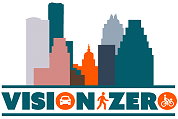 The city, according to an ambitious plan passed three years ago, would like to bring the number of annual traffic deaths down to zero by 2025. One of the primary solutions the city is looking at is implementing more stringent speed management efforts. “We shouldn’t have to wait until someone is injured … to address speed,” said Lewis Leff of the Austin Transportation Department, speaking at the Aug. 5 meeting of the Public Safety Commission.
The city, according to an ambitious plan passed three years ago, would like to bring the number of annual traffic deaths down to zero by 2025. One of the primary solutions the city is looking at is implementing more stringent speed management efforts. “We shouldn’t have to wait until someone is injured … to address speed,” said Lewis Leff of the Austin Transportation Department, speaking at the Aug. 5 meeting of the Public Safety Commission.
In order to do this, ATD is departing from its previous approach of addressing speeding when citizens report a hazard on certain streets, and instead moving to a citywide, data-based approach to identifying streets with the most crashes. The Transportation Department’s Eric Bollich told the commission, “Seventy percent of our crashes are happening on 8 percent of our streets.” The data he presented to the commission shows that the most dramatic increase in fatalities occurs when the speed limit is raised from 30 to 35 miles per hour.
Traffic calming – the term for various efforts to reduce speeding – is part of an initiative called Vision Zero, which aims to reduce the number of people who die or are seriously injured in traffic crashes to zero. This includes motorists inside vehicles as well as cyclists and pedestrians who are involved in crashes. Commissioner Preston Tyree pointed out this distinction, saying that in Austin, “there have been more people to die outside of automobiles than inside.” While the overall number of traffic fatalities has been decreasing since 2015, when the Austin Police Department issued a report on types of traffic fatalities this past spring, Chief of Staff Troy Gay confirmed that there was a 35 percent increase in pedestrian fatalities from 2017-2018.
How would you change Austin roads? Here’s your chance to be heard
July 2019 – (KXAN) — Drive around Austin and you’ll notice some streets have mini-roundabouts, others have signs that read “Drive Like Your Child Lives Here,” and some have speed-activated warning signs to let you know how fast you’re going. The measures are tools the City of Austin’s Transportation Department can use to help reduce speed on Austin’s road and improve safety. That’s why transportation officials are working to create a new Speed Management Program that will become the guidelines for measures and solutions to help reduce speed and improve safety. They’re asking the community for feedback.
They want to know which measures the community prefers for busy neighborhood streets like Bolm and Vargas roads or Barton Hills Drive, and what measures they prefer for congested corridors like Parmer Lane, Burnet Road, Airport Boulevard and William Cannon Drive. Click HERE to view the Austin Strategic Mobility Plan Street Network Map. They hope the new program will help reduce serious injuries and fatal crashes on Austin and help achieve the city’s Vision Zero goal of zero traffic deaths by the year 2025.
‘Concerning to us’: Chief Manley says trends show rise in Austin traffic fatalities
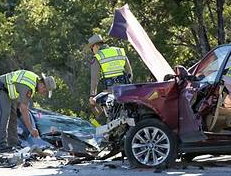 May 17, 2019 – KXAN — Austin has seen a 30 percent increase in traffic fatalities for 2019, and we haven’t even gone through what Police Chief Brian Manley said is statistically the deadliest month of the year: July. Chief Manley laid out traffic trends the force is seeing so far for this year in a press conference on Friday. “We’re seeing some trends that are concerning to us,” he said. There are factors Chief Manley lists that contribute to fatalities including: People using their phones while driving — Attempts to cross I-35 –Not using crosswalks — Driving while intoxicated.
May 17, 2019 – KXAN — Austin has seen a 30 percent increase in traffic fatalities for 2019, and we haven’t even gone through what Police Chief Brian Manley said is statistically the deadliest month of the year: July. Chief Manley laid out traffic trends the force is seeing so far for this year in a press conference on Friday. “We’re seeing some trends that are concerning to us,” he said. There are factors Chief Manley lists that contribute to fatalities including: People using their phones while driving — Attempts to cross I-35 –Not using crosswalks — Driving while intoxicated.
New scooter health study finds injuries preventable, could shape Austin policy
 May 2, 2019 – Statesman.com — A first-of-its-kind study on injuries related to dockless electric scooters found that most incidents were preventable, and now Austin city officials are hoping to use their findings to inform future policy. The CDC said the study found “a high proportion of e-scooter related injuries involved potentially preventable risk factors, such as lack of helmet use or motor vehicle interaction.” City officials also said almost half the head injuries documented could have been prevented.The city’s health and transportation departments collaborated with the Centers for Disease Control and Prevention to review 271 reports of possible scooter related injuries filed from Sept. 5 to Nov. 30, 2018. The study, however, only confirmed 190 cases involved scooter riders, one involved a pedestrian and one involved a cyclist. The rest were determined to be hurt while riding a gas-powered scooter, moped or device that uses three wheels, or didn’t involve a device at all, said Jeff Taylor, an Austin Public Health epidemiologist. Read Full Story
May 2, 2019 – Statesman.com — A first-of-its-kind study on injuries related to dockless electric scooters found that most incidents were preventable, and now Austin city officials are hoping to use their findings to inform future policy. The CDC said the study found “a high proportion of e-scooter related injuries involved potentially preventable risk factors, such as lack of helmet use or motor vehicle interaction.” City officials also said almost half the head injuries documented could have been prevented.The city’s health and transportation departments collaborated with the Centers for Disease Control and Prevention to review 271 reports of possible scooter related injuries filed from Sept. 5 to Nov. 30, 2018. The study, however, only confirmed 190 cases involved scooter riders, one involved a pedestrian and one involved a cyclist. The rest were determined to be hurt while riding a gas-powered scooter, moped or device that uses three wheels, or didn’t involve a device at all, said Jeff Taylor, an Austin Public Health epidemiologist. Read Full Story
Jacqui Saburido, the face of campaigns against drunken driving, dies at 40
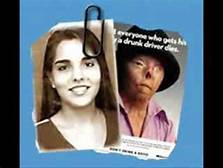 April 22, 2019 – Statesman.com — Jacqueline Saburido Garcia, who became the face of campaigns in Texas and beyond against drunken driving after she was severely burned in a wreck near Lake Travis 20 years ago, died Saturday of cancer in Guatemala, according to her family. She was 40. Saburido was 20-year-old studying in Austin when tragedy struck on the night of Sept. 19, 1999.
April 22, 2019 – Statesman.com — Jacqueline Saburido Garcia, who became the face of campaigns in Texas and beyond against drunken driving after she was severely burned in a wreck near Lake Travis 20 years ago, died Saturday of cancer in Guatemala, according to her family. She was 40. Saburido was 20-year-old studying in Austin when tragedy struck on the night of Sept. 19, 1999. 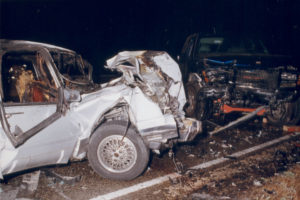 Reggie Stephey, an 18-year-old student at Lake Travis High School, was driving home from another party in Austin. He had been drinking. On a curve along RM 2222, Stephey’s SUV plowed into the car carrying Saburido and her friends. The crash killed the driver, Natalia Chyptchak Bennett, and Laura Guerrero as the car as it burst into flames. Saburido, trapped in the front passenger seat, burned for nearly a minute before paramedics could put out the fire.
Reggie Stephey, an 18-year-old student at Lake Travis High School, was driving home from another party in Austin. He had been drinking. On a curve along RM 2222, Stephey’s SUV plowed into the car carrying Saburido and her friends. The crash killed the driver, Natalia Chyptchak Bennett, and Laura Guerrero as the car as it burst into flames. Saburido, trapped in the front passenger seat, burned for nearly a minute before paramedics could put out the fire.
Man gets 10 years for violating probation in fatal 2017 Georgetown hit-and-run
April 22, 2019 – Stateman.com – A man whose release from jail sparked outrage after he pleaded guilty in the 2017 hit-and-run death of a Georgetown bicyclist has been sentenced to 10 years in prison for violating his probation in the case. Aaron Davison, 22, was released from jail in March 2018 without serving any time in prison for the death of 19-year-old Tommy Ketterhagen because of a state mandatory supervision law. On Thursday, state District Judge Rick Kennon sentenced Davison to 10 years in prison.
2019 deadliest on Bastrop County roads in past decade
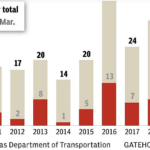 April 3, 2019 – Statesman.com — Traffic-related deaths on Bastrop County roads in the last two weeks have made the first three months of 2019 the deadliest start to a year in at least the past 10 years, according to state crash statistics. State police have recorded 16 traffic fatalities in Bastrop County between January and March, a figure that even outpaces the 11 fatalities the city of Austin saw during the same time period. From 2010 to 2018, Bastrop County had between one and 13 traffic-related deaths in the first three months each year, with only one reported in 2014 and 13 in 2016, according to Texas Department of Public Safety data. Over the weekend, six people died in two separate crashes along Texas 21 and U.S. 290, bringing the county’s traffic death toll to 16 so far this year.
April 3, 2019 – Statesman.com — Traffic-related deaths on Bastrop County roads in the last two weeks have made the first three months of 2019 the deadliest start to a year in at least the past 10 years, according to state crash statistics. State police have recorded 16 traffic fatalities in Bastrop County between January and March, a figure that even outpaces the 11 fatalities the city of Austin saw during the same time period. From 2010 to 2018, Bastrop County had between one and 13 traffic-related deaths in the first three months each year, with only one reported in 2014 and 13 in 2016, according to Texas Department of Public Safety data. Over the weekend, six people died in two separate crashes along Texas 21 and U.S. 290, bringing the county’s traffic death toll to 16 so far this year.
APD investigates causes of traffic fatalities
March 12, 2019 – AustinMonitor – As busy and congested as Austin streets have become, drivers have managed to keep the number of traffic fatalities from rising over the last few years. “We’re on a four-year downward trend,” Ron MacKay, Austin Police Department’s crime analysis division manager, said at the March 4 meeting of the Public Safety Commission. According to the statistics he shared with the commission, traffic fatalities have been cut nearly in half since 2015, while the population has risen by nearly 100,000 residents.
This most recent downward trend is coming on the heels of 2015’s spike in traffic fatalities … Commissioner Preston Tyree pointed out that while overall numbers are decreasing, the mix of those suffering fatal accidents is changing as more Austinites take to walking downtown and riding electric scooters. Austin Police Department Chief of Staff Troy Gay confirmed these observations, saying that there was a 35 percent increase in pedestrian fatalities from 2017 to 2018. Read Full Story Here
Pedestrian deaths reached record levels in 2018, police data show
Pedestrians made up 42 percent of all traffic deaths in Austin last year — the largest proportion in recent years, according to available police data — and more pedestrians died on Interstate 35 than on any other road in the city, an American-Statesman analysis found. In 2018, the city saw 74 traffic deaths, including 31 pedestrians hit and killed by vehicles, making it the deadliest year for pedestrians since 2008. The rate is the highest since 2011, when pedestrians made up 41% of 54 total traffic deaths. In 2017, pedestrians made up about 30% of 76 deaths. 15 of the pedestrian deaths happened on major highways, including 11 on I-35 or one of its service roads, the data show. Four of the crashes involved an 18-wheeler.
Texas 71 speed limit lowered from 60 to 55
On Feb. 1, 2018 the speed limit on Texas 71 West, from Bee Cave’s western city limits to the Pedernales River was lowered from 60 to 55 mph. The TXDOT decision was the culmination of a lot of behind-the-scenes negotiations from a group of residents who drive the western Travis County corridor daily. Safer71 was created by Sweetwater resident Greg Short following the Oct. 28 death of his neighbor, Dr. Michael Babineaux, on Texas 71 near his home.
Slow your roll: New bill could reduce speed in residential areas across Texas
Feb. 10, 2019 — KVUE — A new bill could slow down your driving speed around neighborhoods. The bill, introduced to the Texas House of Representatives, is looking to reduce the speed from 30 to 25 mph in residential areas. House Bill 1287 was introduced by Texas Representative Celia Israel, relating to the speed limit on certain streets and highways. “It’s incredibly rough on the family,” said Kathy Sokolic, who lives around the Mueller neighborhood in Austin.
Deaths On Austin Roads Down Slightly In 2018, Two Years Into Traffic Safety Campaign
Jan. 8, 2019 – KUT.org — By Audrey McGlinchy — Road deaths in Austin dropped slightly in the city’s second full year of a campaign for traffic safety. Seventy-four people died on city streets in 2018, according to numbers from the Austin Police Department. That’s two fewer deaths than the year before.
“The first reaction is that’s a terrible tragedy; 74 people died,” said Jay Blazek Crossley, executive director of Farm & City, a nonprofit that advocates for safer transit throughout the state. “That being said, considering where we were this summer where it seemed like Austin was on the path to increasing deaths, it’s really great that something happened and we didn’t increase,” he said. “The city is still on its path of reducing traffic deaths to zero.” The Austin Transportation Department was unable to provide comment by deadline.
Pedestrian deaths typically account for roughly a third of all traffic fatalities. But in 2018, pedestrians died at a higher rate than years past. Pedestrians accounted for 42 percent of traffic deaths last year, compared with 30 percent the year before. Crossley said pedestrian deaths can often be attributed to street design and speed. “We have many, many streets that are designed to encourage people to drive 40, 50. It feels uncomfortable to drive 30 miles per hour on North Lamar,” he said, arguing the street is designed for cars to go faster.
Austin police issued 30% fewer traffic citations this year
 Dec. 27, 201 8 – Statesman.Com — Traffic citations issued by Austin police took a notable dip this year compared with 2017, a drop that seems to fit a downward trend in the past few years, police data show. The exact reasons for the decrease are unclear, but police believe several factors could have contributed, including changes in a law enforcement grant that required officers to issue citations, the temporary removal of hundreds of police vehicles from patrol for repairs and a lower rate of crashes in the city.
Dec. 27, 201 8 – Statesman.Com — Traffic citations issued by Austin police took a notable dip this year compared with 2017, a drop that seems to fit a downward trend in the past few years, police data show. The exact reasons for the decrease are unclear, but police believe several factors could have contributed, including changes in a law enforcement grant that required officers to issue citations, the temporary removal of hundreds of police vehicles from patrol for repairs and a lower rate of crashes in the city.
Police wrote about 68,300 citations from January through November, 30 percent fewer than in the same period in 2017, according to data from the Austin Municipal Court. The number of citations decreased steadily through the past four years, though not as sharply as in the past 12 months. Citations dropped 13.1 percent from 2015 to 2016 and 10.9 percent from 2016 to 2017.
Austin’s Vision Zero: Traffic deaths slipping but pedestrians still at risk
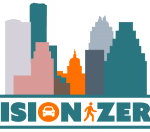 Dec. 13, 2018 – by Maria Mendez – Statesman.com — With the passage of the Vision Zero Action Plan in May 2016, the Austin City Council decided it wanted to reach zero deaths on Austin roads by 2025. Almost three years later, reaching Vision Zero by 2025 seems like a stretch, but the plan appears to be reducing traffic deaths. Now, Vision Zero leaders want to focus their efforts on reducing losses among particularly vulnerable populations: pedestrians in East Austin and underserved neighborhoods.
Dec. 13, 2018 – by Maria Mendez – Statesman.com — With the passage of the Vision Zero Action Plan in May 2016, the Austin City Council decided it wanted to reach zero deaths on Austin roads by 2025. Almost three years later, reaching Vision Zero by 2025 seems like a stretch, but the plan appears to be reducing traffic deaths. Now, Vision Zero leaders want to focus their efforts on reducing losses among particularly vulnerable populations: pedestrians in East Austin and underserved neighborhoods.
Austin’s traffic deaths reached a peak of 102 in 2015, with 11.3 deaths per capita locally surpassing the national per capita rate of 10.9 deaths per 100,000 people, according to calculations from Austin police’s 2015 traffic report and national data from the Institute for Highway Safety and the Highway Loss Data Institute. Austin, though, remained below the state’s per capita rate of 12.8 traffic fatalities. Traffic deaths can spike from time to time, but Austin’s growing population most likely contributed to the 2015 peak, said Laura Dierenfield, the active transportation program manager for Austin’s Transportation Department.
Austin’s population has only continued to grow since, reaching 967,629 people in 2018, but traffic fatalities have declined since 2015 and since the Austin City Council adopted a Vision Zero action plan in 2016.
A lack of crosswalks also is linked to more pedestrian deaths, according to the pedestrian plan and other studies. “A lot of times people are trying to catch a bus on one side of the road, or they’ll try to find a friend picking them up on the other side of the road, and they don’t want to walk all the way to a walk signal,” Kara Kockelman, a University of Texas transportation engineering professor, said. Read Full Story Here
Federal health experts to study Austin scooter crashes
Experts from the U.S. Centers for Disease Control and Prevention are descending on Austin to study a new public health concern — dockless scooters. Officials with Austin Public Health and Austin Transportation departments are working with three CDC epidemiologists, who will conduct the nation’s first-ever study of the patterns associated with dockless scooter crashes and how to prevent them.
“The scooters are new, so we don’t know all the things about factors related to injury and the severity of injuries,” Dr. Philip Huang, health authority and medical director for Austin Public Health, told the American-Statesman. “It’s just a new problem to try to get a better understanding of what is going on, what are some of the dangers and what we might try to do to prevent injuries.” The epidemiologists will begin conducting interviews next week, focusing on 37 EMS calls and 68 scooter injuries reported over a 60-day period, from Sept. 5 to Nov. 4. Data collected will be used to educate city officials as they work to adopt new scooter rules. The City Council is expected to vote on new rules for dockless scooters as soon as March of next year, after the completion of the safety study. Read Full Story Here
Vision Zero pushes for alternatives to Austin’s car culture
 As the plan approaches its third year, traffic fatalities are on pace to exceed the city’s average
As the plan approaches its third year, traffic fatalities are on pace to exceed the city’s averageIntersection improvements. Downtown’s new Sobering Center. The scooters. Austin Police Department officers riding a Capital Metro bus looking, from their perch, for drivers who are texting. These are some of the initiatives that fall under the city of Austin’s Vision Zero action plan, which City Council adopted in 2016 following a record-high year for traffic fatalities.
It was produced by a network of partners, including the city’s planning and zoning, police, public health, public works, and transportation departments; the bicycle and pedestrian advisory councils; the Mayor’s Committee for People with Disabilities; local nonprofits; Capital Metro; and the Texas Department of Transportation.
The goal? To reach zero traffic fatalities and serious injuries by 2025. As the plan enters its third year, however, at least 57 people have died in Austin in 2018, a nearly 12-percent increase from this time last year. “I think it is difficult to have an expectation on an issue that is so complex and [for which]the solutions demand such a broad spectrum of action,” said Laura Dierenfield, active transportation program manager for the Austin Transportation Department.
In line with the plan, city staff and safety advocates agree that traffic fatalities will decrease only when there are fewer cars moving at lower speeds on higher-density streets shared with people using other forms of transportation: bikes, dockless mobility, public transportation and their own two feet. But they also acknowledged that, in a city full of commuters with a developing public transit system, this is a hard task.
Lake Travis community pushes to make Texas HWY 71 West safer
Nov 21, 2018 – Statesman.com — On a beautiful early November afternoon, Kimberly Horton and Meghan Taylor were busy tying ribbons along Pedernales Summit Parkway, the main entrance off Texas 71 to Sweetwater, their western Travis County subdivision. Although the gesture was intended to welcome home a new mother, Andria Babineaux, and her baby, the occasion was bittersweet since Andria’s husband, Dr. Michael Babineaux, died in a car wreck Oct. 29, only three days before she gave birth to the couple’s third child.
Accounts of the wreck say the driver of a pickup heading west on 71 entered the center turn lane to pass the vehicle in front of him when he lost control and crashed into Babineaux’s vehicle near Serene Hills Drive, within a few miles of the physician’s home. She said the ribbons have another meaning — as a way of bringing awareness that “this is a very dangerous stretch of (Texas) 71.”
According to the Texas Department of Transportation’s crash records, nine deadly crashes have occurred since January 2017 on Texas 71 between Spanish Oaks Boulevard and Fall Creek Road at the border between Travis and Blanco counties, a tally that Babineaux’s neighbor Greg Short says is unacceptable. Short said he founded the Safer71 nonprofit after he lost his friend on the highway and vowed to “achieve a zero-fatality corridor along the roadway.”
Short said Safer71 aims to have state and regional transportation agencies:
• Extend the 50 mph speed limit that exists on the portion of Texas 71 in Bee Cave to Pace Bend Road, where the speed is 60 mph;
• Add a median or divide the road from the city of Bee Cave to Pace Bend Road;
• Complete a resurfacing project that began last year as a temporary grading measure to decrease the potential for vehicles hydroplaning in wet weather;
• Engineer a better entrance and exit to Sweetwater;
• Add signage to the area.
Short said the group’s mission is aligned with TxDOT’s safety recommendations and the proposed Texas 71 solutions would, similarly, cover engineering, enforcement and education for commuters and residents on safe driving habits, distracted driving risks and speeding risks.
Read Full Story ….. RELATED: Lawmakers address crash problem on scenic Texas 71 in Spicewood
2 out of 3 child safety seats misused – Now TxDOT to offer free safety seat inspections
 AUSTIN – With motor vehicle crashes still a leading cause of death among children, the Texas Department of Transportation is joining safety advocates statewide to remind parents of the importance of always buckling up their children. That means not only making sure they’re secured in their vehicle, but also avoiding the most common mistakes when it comes to child safety seats: failing to select the seat that is appropriate for the child’s age and size, and failing to correctly install it.
AUSTIN – With motor vehicle crashes still a leading cause of death among children, the Texas Department of Transportation is joining safety advocates statewide to remind parents of the importance of always buckling up their children. That means not only making sure they’re secured in their vehicle, but also avoiding the most common mistakes when it comes to child safety seats: failing to select the seat that is appropriate for the child’s age and size, and failing to correctly install it.
As part of its September “Save Me with a Seat” campaign, TxDOT is encouraging parents to sign up for a free child safety seat check-up at any of its 25 district offices located throughout Texas. While most parents believe their children are properly buckled up, the NHTSA says 2 out of 3 safety seats are not used correctly. In Texas, in 2017: 408 children younger than 8 years old were seriously injured and 73 died in traffic crashes. And 411 children ages 8 to 12 were seriously injured and another 30 were killed. To protect against injury, TxDOT recommends that all children under age 13 ride in the back seat, properly secured in a seat belt or safety seat. State law requires all children under 8 years old, unless they are taller than 4 feet 9 inches, to be in a safety seat whenever they ride in a vehicle. Failure to properly restrain a child can result in a ticket of up to $250.
Leading up to National Child Passenger Safety Week, Sept. 23–29, TxDOT is partnering with Build-A-Bear Workshop® to hold outreach events at malls in five Texas cities. While specialists are conducting safety seat demonstrations, Build-A-Bear® will provide activities for children. Safety events are planned in Hurst, Waco, Brownsville, Corpus Christi and Katy. “Save Me with a Seat” campaign materials also will be available at all 35 Build-A-Bear locations in Texas on Sept. 29. TxDOT’s free safety seat inspections are available weekdays – about 20 to 30 minutes. To schedule with a TxDOT Traffic Safety Specialist, visit SaveMeWithaSeat.org.
Drunk scootering becoming an issue for one Texas city
August 16, 2018 – (KEYE) — Drunk scootering is becoming an issue in Downtown Austin, Texas. The city is working with police on the safety issues that have arisen with dockless scooters and bikes. According to Austin Police riding a scooter while drunk can lead to a DWI. A spokeswoman for Austin Transportation Department said that issue hasn’t come up yet, but the transportation department plans to work more with the police. They say enforcement can help, but education can be one of the best tools.
APTA and Vision Zero Network analysis touts higher public transit as a key to safety
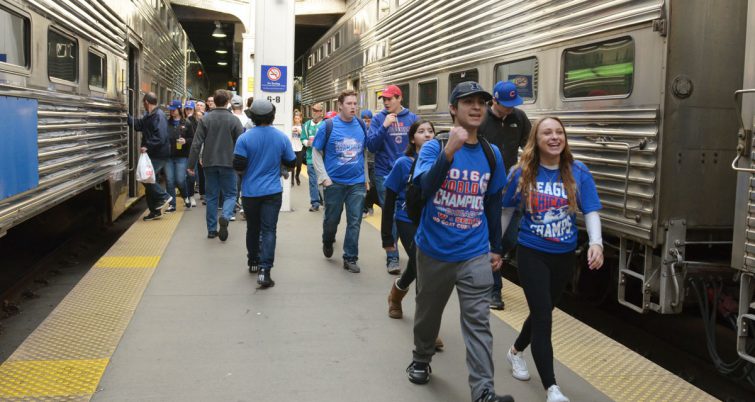
A new research analysis released Aug. 29 by the American Public Transportation Association (APTA) and the Vision Zero Network, a nonprofit campaigning to end vehicle traffic fatalities, suggests cities with higher public transit use can cut their traffic fatality rates by as much as 40 percent. The analysis, entitled “Public Transit is a Key Strategy in Advancing Vision Zero and Eliminating Traffic Fatalities,” reveals metropolitan areas with high rates of public transportation use see lower traffic fatality rates, APTA explained.
“Every day, 100 people die due to traffic crashes on America’s roads, and increasingly communities are committing to Vision Zero because they believe everyone deserves to be safe on our streets,” said Leah Shahum, founder and director of the Vision Zero Network. “Investing in strong public transit systems helps communities improve safety for everyone on the roads. For too long, we have undervalued the significant safety benefits of robust public transit networks, so we look forward to stepping up cooperation to grow public transit and safety together.”
“Public transportation is an important safety tool because it allows high risk drivers, such as those who are drinking or fatigued or distracted, as well as those who are simply inexperienced or unable to drive for health reasons, to be able to get around without endangering themselves and others,” Dinh-Zarr said. “I am pleased to learn about this APTA and Vision Zero Network partnership and report which I hope will help all of us put safety first in our communities and our nation, no matter what form of transportation we choose.”
Traffic law enforcement still a not topic
August 15, 2018 – AustinMonitor – Even though traffic law enforcement and street safety is a top priority for the Austin Police Department, the majority of officers have little time to devote to such enforcement, given their other priorities, such as responding to citizens’ calls and engaging in community policing efforts. That is the major conclusion of an audit report produced by members of the city auditor’s team and discussed at the City Council Audit and Finance Committee on Tuesday.
 Cameron Lagrone, the auditor-in-charge of the audit, told the committee that officers spend 79% of their time on duty responding to calls for service, leaving only 21% of their time available for other duties. APD Assistant Chief Justin Newsom reminded Council members that Chief Brian Manley has emphasized that his officers need to do community outreach. Newsom told the Austin Monitor, “Our push, and especially since Chief Manley has been chief, is community engagement. He added that decisions about where to concentrate traffic enforcement efforts are “based on deaths and serious injuries. We have to focus our limited traffic enforcement resources where the greatest impact is happening. And that’s the high-speed roadways and the major intersections.”
Cameron Lagrone, the auditor-in-charge of the audit, told the committee that officers spend 79% of their time on duty responding to calls for service, leaving only 21% of their time available for other duties. APD Assistant Chief Justin Newsom reminded Council members that Chief Brian Manley has emphasized that his officers need to do community outreach. Newsom told the Austin Monitor, “Our push, and especially since Chief Manley has been chief, is community engagement. He added that decisions about where to concentrate traffic enforcement efforts are “based on deaths and serious injuries. We have to focus our limited traffic enforcement resources where the greatest impact is happening. And that’s the high-speed roadways and the major intersections.”
Even though the city has set a goal of having zero traffic deaths or serious injuries on Austin roadways by 2025, that goal, called Vision Zero, must compete with the other important goal of improving relationships between the police and members of the community. As of Aug. 1, “citywide patrol capacity was at 82% total staffing, with 84 vacancies and 52 officers on long term leave,” according to the report. In order to increase traffic law enforcement, the city relies on a grant from the Selective Traffic Enforcement Program, or STEP, which is administered by the TXDOT. According to the report, the city receives about $1 million per year to pay for enforcement efforts focused on speeding, distracted driving, impaired driving and other causes of vehicle crashes. For the calendar year 2017, APD reported that its officers averaged 1,173 hours of traffic “enforcement per month through the STEP grant, and issued a large percentage of the traffic citations issued by APD.” According to an analysis by the audit team, officers working under the STEP program issued 54 percent of APD’s speeding citations, 62 percent of the city’s seat belt citations and 48 percent of citations issued for distracting driving in 2017, as well as citations for failure to have a child safety seat and violation of intersections signals.
Austin teen arrested for intoxication assault after hit and run critically injures man at bus stop
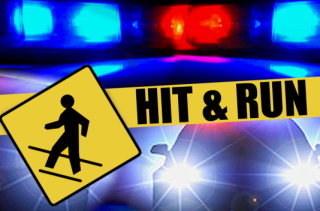 Austin police have arrested a man who’s suspected of driving drunk and crashing into an East Austin bus stop Friday, leaving one man seriously injured, court documents state. Dipak Thapa, 19, has been charged with intoxication assault and accident involving serious bodily injury following the crash that happened at around 5:40 p.m. Friday. Police were called to the 2400 block of East Riverside Drive, just west of Pleasant Valley Road for the vehicle-pedestrian crash and found a 60-year-old man, whose right leg had been severed. He was transported to a hospital, where doctors discovered the man also was bleeding from his brain, an arrest affidavit said. A wrecked Toyota Camry was located on the scene, but the driver, Thapa, had fled the vehicle, court documents said.
Austin police have arrested a man who’s suspected of driving drunk and crashing into an East Austin bus stop Friday, leaving one man seriously injured, court documents state. Dipak Thapa, 19, has been charged with intoxication assault and accident involving serious bodily injury following the crash that happened at around 5:40 p.m. Friday. Police were called to the 2400 block of East Riverside Drive, just west of Pleasant Valley Road for the vehicle-pedestrian crash and found a 60-year-old man, whose right leg had been severed. He was transported to a hospital, where doctors discovered the man also was bleeding from his brain, an arrest affidavit said. A wrecked Toyota Camry was located on the scene, but the driver, Thapa, had fled the vehicle, court documents said.
Thapa was later found and taken to the hospital for treatment of his injuries, the affidavit said. Police said Thapa appeared intoxicated, and he admitted to officers he had drank two 16-ounce beers before the crash, the document said. Records show Thapa was booked into the Travis County Jail on Friday after he was released from the hospital. His bail has not been set. Both charges are third-degree felonies punishable by between 2 to 10 years in prison.
Driver arrested after man was hit and killed at south Austin bus stop
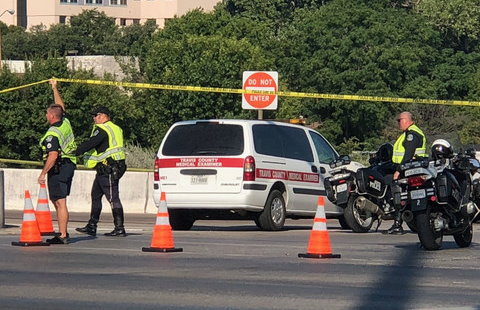 Aug 01, 2018 – KXAN – AUSTIN (KXAN) — The driver who police say hit and killed a man while he was waiting at a bus stop in south Austin and left the scene Wednesday morning has been arrested. Darrell Shane Smitty, 52, has been charged with failure to stop and render aid, with bond set at $100,000. The crash happened around 8 a.m. at the intersection of South First Street and West Ben White Boulevard. Austin police say a white GMC Sierra 4-door pickup truck with the license plate AD68179 was in the far right turn lane, westbound on the frontage, waiting at a red light with a Capital Metro bus to its left (in the straight lane).
Aug 01, 2018 – KXAN – AUSTIN (KXAN) — The driver who police say hit and killed a man while he was waiting at a bus stop in south Austin and left the scene Wednesday morning has been arrested. Darrell Shane Smitty, 52, has been charged with failure to stop and render aid, with bond set at $100,000. The crash happened around 8 a.m. at the intersection of South First Street and West Ben White Boulevard. Austin police say a white GMC Sierra 4-door pickup truck with the license plate AD68179 was in the far right turn lane, westbound on the frontage, waiting at a red light with a Capital Metro bus to its left (in the straight lane).
When the light turned green, police say the driver in the pickup truck, instead of turning right like he was supposed to, accelerated to try to beat the bus going straight. As the bus was coming to a stop at the bus stop, the pickup truck driver “jumped the curb, drove down the sidewalk” and struck 40-year-old Ernesto Garcia. ……… Garcia’s is at least the fifth person hit and killed by a vehicle in Austin in the past two weeks. On Sunday a man was hit and killed crossing Manchaca Road, a man crossing I-35 downtown was hit by a couple vehicles Friday, on Thursday a man walking on the sidewalk was hit by a car that then careened into a ravine in north Austin and a cyclist found a man’s body by the side of the road last Monday.
The area of Wednesday’s hit-and-run is not among the city’s most dangerous, but people have plenty to say about it, according to an interactive map the City created for people to share their concerns. People have said it’s hard for people to see each other near the intersection of South First Street and Ben White Boulevard, and that people don’t always use the crosswalks. Other areas of the city feature more comments.
VisionZero Commentary – “This has to change”
“Pedestrian deaths have risen 46% across the country. Last year at this point on the year in Austin we had 8 people killed while walking, this year there have been 15 people killed in Austin while walking. Across Texas in 2017, 613 people were killed by vehicles while walking. KXAN also noted that the Insurance Institute for Highway Safety has released a report calling for reigning in speed increases, redesigning roads to make them safer for pedestrians, and changing the design of trucks and SUVs to make them less deadly (as they already do in Europe). When this truck was speeding around the bus and jumped the curb it went into the clear zone. The clear zone is an area TxDOT designs into the roadway where out of control vehicles can “recover.” The problem here is that TxDOT intentionally puts sidewalks in clear zones, and will not allow an “fixed hazardous objects” that would protect a person on the sidewalk. So, for example, TxDOT will not allow street trees (or other fixed objects) that could have helped protect Ernesto while he was waiting at the bus stop. The TxDOT Roadway Design Manual STILL requires a 4 foot clear zone on all of the urban corridors they control in the City of Austin.”
Use crosswalks, slow down: City urges caution after pedestrian deaths
Transportation officials remind residents to use crosswalks and to slow down while driving to avoid accidents. After three people were hit and killed by vehicles this week, Austin transportation officials are reminding pedestrians to stick to crosswalks and drivers to slow down. Early Friday, a man in his 20s tried to cross southbound Interstate 35 near Sixth Street and died after being hit by an 18-wheeler, police said. No one was charged in the incident. Another man, in his 40s, died Thursday after a vehicle hit him in the westbound lanes of East Anderson Lane at Norwood Park Boulevard about 8:40 a.m. Police are still investigating the crash.
And on Monday morning, Scott Gerald Whiting, 37, was killed in a hit-and-run in the 5700 block of West Parmer Lane. A bicyclist found him lying in the road near McNeil Drive and called police. Investigators said Whiting was walking in the bike lane or on the grassy shoulder when he was hit. A suspect has not been identified. Twenty-three pedestrians were killed in auto crashes last year and 28 in 2016, police data shows. So far this year, 14 pedestrians have been killed in auto crashes, including the incidents from this week.
Police say the number of traffic fatalities this year is not unusual. “We range between 60 to 70 traffic fatalities throughout the year, so we’re on pace to hit that,” Austin police officer Bino Cadenas said. “Again, we’d like to remind the public to please utilize the intersection if you’re going to cross.” Low visibility, speeding, drunken driving and crossing in unsafe areas are often factors in pedestrian deaths, said Joel Meyer, the city’s pedestrian coordinator for the Pedestrian Safety Action Plan. Crashes often occur at night when it’s hard to see people on the road or sidewalks, he said. And the faster a driver goes, the more difficult it becomes for the driver to slow down and avoid pedestrians. “These areas that were designed for car travel don’t mix with more pedestrians,” he said.
Data show Austin saw the lowest number of total traffic fatalities in 2010 when 49 people were killed. The worst year for traffic deaths was in 2015, when 102 people were killed. Since then, the Austin area has had 79 deaths in 2016 and 75 in 2017. As Austin has grown, the demand for walkable spaces and transit use has increased, Meyer said. Areas that are walkable are often less affordable, causing residents to move outward into areas along highways, he said. Austin’s homeless population is also at risk of pedestrian crashes because a large number of them shelter under overpasses near the road. “That’s just not a good combination,” Meyer said. The city is improving a number of intersections to make them safer for pedestrians.
3 out of last 5 fatal crashes in Austin involved a suspended license
 July 26, 2018 – CBSAustin — A recent spike in crashes involving drivers with suspended licenses is leading APD to look back into an ordinance to get those drivers off the road. Austin Police say three of the past five fatal crashes in Austin involved someone with a suspended license. One driver had 19 suspensions on her record. “19 active suspensions, that’s bad driving,” APD detective Patrick Oborski said.
July 26, 2018 – CBSAustin — A recent spike in crashes involving drivers with suspended licenses is leading APD to look back into an ordinance to get those drivers off the road. Austin Police say three of the past five fatal crashes in Austin involved someone with a suspended license. One driver had 19 suspensions on her record. “19 active suspensions, that’s bad driving,” APD detective Patrick Oborski said.
Oborski said it’s a common trend in Austin and this year he says they’ve seen a lot of crashes involving drivers with no license or a suspended one. “The sheer numbers, it’s out of control,” Oborski said. “The likelihood of you being in a crash with a suspended license is much higher than actually being in one with a drunk driver.”
So far this year there have been 1,485 crashes involving a driver without a valid license. There have also been ten fatal crashes involving no valid license. Those numbers don’t show a spike compared to 2017, but they do outnumber fatal DWI crashes at eight. Oborski said they’re talking with the city to add an ordinance to allow them to tow drivers without a valid license. “The problem is right now we’re just issuing citations and letting people drive off and to me it’s like if someone being involved in a murder you give them the gun back,” Oborski said.
A couple years ago, Vision Zero in Austin talked about adding similar enforcements. However, Jay Crossley said they thought it wasn’t equitable to lower income drivers. “There were lots of concerns about equity measures,” Crossley said.
According to Emily Gerrick, an attorney with the Texas Fair Defense Project, a majority of people without a valid license are because they couldn’t afford fees. “Not because they’re bad drivers but just because they can’t afford to climb out of this hole,” Gerrick said. “They would have their licenses if they had money.” That’s why she says towing their vehicle that allows them to drive to a job is not a solution. “I think it would drive people deeper into poverty,” Gerrick said.
Oborski said they would look to differentiate between drivers who just couldn’t pay fees and the dangerous drivers with suspended licenses. “We’re not really concerned with surcharges and things like that we’re looking at the ones more bad driving, bad habits things like that,” Oborski said. He also said drivers without a valid license should not be on the road. “I understand that people have needs but also my family has a need to be safe,” Oborski said.
CBSAustin- by Adam Hammons
More than half of drivers don’t look for people walking or cycling when turning right

Now new research from the University of Toronto School of Engineering proves the point: you cannot rely on people to do the right thing, you have to design the roads to prevent problems. In this study Nazli Kaya, working under supervision of professor Birsen Donmez, found that more than half of drivers they studied failed to scan for cyclists at right turns. While wearing eye-tracking equipment, the drivers made right turns from a major artery to a side street, crossing a bike lane that I use regularly, feeling more safe and protected than I did before they installed the controversial lane. It evidently was a false sense of security. She reiterates also what we have said about vision zero (and everything else) — that it is all about design.
Cities Are Replacing Dangerous Slip Lanes With Space for People
July 13, 2018 – STREETBLOGUSA –When you come across a short segment of asphalt that carves u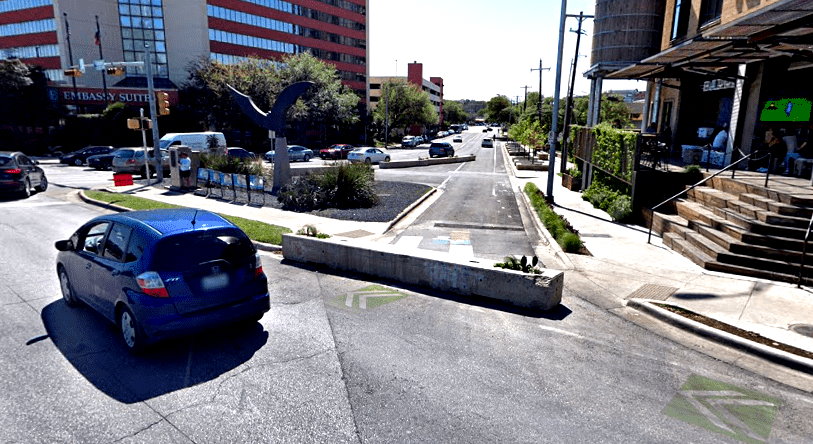 p the sidewalk so drivers can take turns faster — that’s a slip lane, and it’s very dangerous for pedestrians. Slip lanes don’t belong in cities. Since slip lanes serve no purpose except to shave a few seconds off car trips, they’re easy to convert to pedestrian space. And many cities are doing just that. Congress and Barton Springs, Austin — The city of Austin is currently testing out a public plaza at this location with temporary materials. The plan is to build out a permanent project if public feedback is positive following the one-year pilot.
p the sidewalk so drivers can take turns faster — that’s a slip lane, and it’s very dangerous for pedestrians. Slip lanes don’t belong in cities. Since slip lanes serve no purpose except to shave a few seconds off car trips, they’re easy to convert to pedestrian space. And many cities are doing just that. Congress and Barton Springs, Austin — The city of Austin is currently testing out a public plaza at this location with temporary materials. The plan is to build out a permanent project if public feedback is positive following the one-year pilot.

NYC DOT: ‘Vision Zero’ traffic deaths down citywide
Hit-and-runs on the rise in Austin, data show
June 23, 2018 – Statesman – Data show hit-and-run crashes have been increasing over the past seven years. Pedestrians and cyclists are at particular risk, since they are the most often seriously injured or killed.Officials urge drivers to anticipate the worst and always take down a license plate number after a crash.
 A fatal hit-and-run crash that left one man dead in Southeast Austin on Thursday was Austin’s fifth this year, continuing an increase in the number of hit-and-runs that goes back seven years, according to Texas Department of Public Safety data.
A fatal hit-and-run crash that left one man dead in Southeast Austin on Thursday was Austin’s fifth this year, continuing an increase in the number of hit-and-runs that goes back seven years, according to Texas Department of Public Safety data.
The man, identified by police on Saturday as Jason Aranda, was struck walking on East Oltorf Street at Huntwick Drive about 3 p.m. Thursday. Authorities say the driver, a woman they identified as 24-year-old Cierra Powell, hit him intentionally, prompting them to open a homicide investigation.
Others who have died this year in hit-and-runs are:
• Timothy Boykin, who was killed Feb. 9 when 21-year-old driver Olivia Gruwell struck him as he rode his moped on Red River Street in Central Austin, according to arrest documents. Authorities say Gruwell dragged the vehicle under her Jeep all the way to her home. She was charged with failure to stop and render aid and intoxication manslaughter.
• Josman James, who died Feb. 23 after a friend who was following in a Cadillac struck his vehicle on Decker Lane in North Austin, authorities said. The driver was identified in an arrest affidavit as Ashley Shelsea Rodriguez-Dominguez, who was later arrested.
• An unidentified man who was found dead on Interstate 35 on March 15. Investigators believe he was struck by a vehicle. The driver has not been found, police say.
• Robert Copeland, who was in a wheelchair on the I-35 frontage road, just south of Wonsley Drive, when he was struck and killed May 7. Rafael Padilla, identified as the driver in an arrest affidavit, was later arrested.
Austin police detective Adrian Duran urged people to drive defensively and to always anticipate the worst. If you are hit while driving, he said, always take down the vehicle’s license plate number. “I know the first instinct is to get on the phone with your mom or call police,” Duran said. “But without a plate, there is nothing we can do.” Drivers face felony charges if they leave the scene of a crash when someone has been injured in any way. If you hit someone while driving, you should always stop, he said. “It’s never as serious as you think.”
Department of Public Safety data show 1,680 reported hit-and-run crashes in Austin in 2017. That’s a 40 percent increase from 2010, when there were 1,201. In the same period, hit-and-run crashes involving pedestrians increased 76 percent, to 81 in 2017 from 46 in 2010. AAA called 2016 the deadliest year on record for hit-and-runs, with 2,049 deaths nationwide. In Texas that year, at least one person died in 233 hit-and-run crashes. That’s 33 percent more than in 2006, when there were 175 fatal hit-and-run crashes, the Texas data show. Texas ranks eighth in the nation among states with the most hit-and-runs. Daniel Armbruster, a spokesman for AAA, said population growth is the main factor in the rising number of hit-and-run crashes. Nearly 65 percent of people killed in hit-and-run crashes are cyclists or pedestrians, according to AAA.
The most serious hit-and-run crashes, resulting in injury or death, also tend to happen at night in more isolated areas, where drivers believe they can leave without getting caught, Armbruster said. According to the data, fewer than 30 percent of fatal crashes happen between 9 p.m. and 4 a.m. but more than half of all fatal hit-and-runs occur during that time. “If it is dark and there are few cars on the road, they think they have a better opportunity to get away,” Armbruster said.
Texas Statewide Pedestrian Safety Forum
The Texas A&M Transportation Institute, Texas Pedestrian Safety Coalition, and the Texas Department of Transportation held the first annual Pedestrian 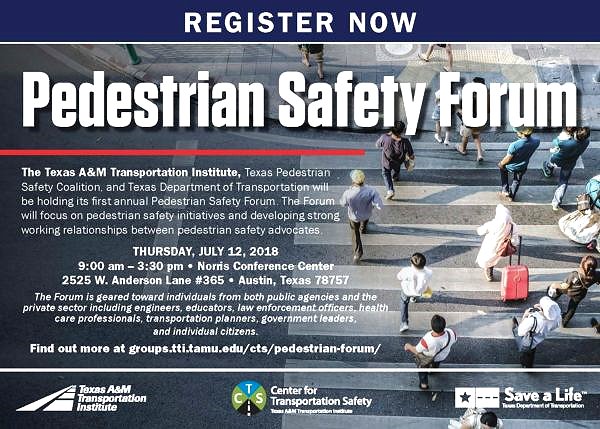 Safety Forum on July 26, 2018 in Austin. The Forum focused on pedestrian safety initiatives and developing strong working relationships between pedestrian safety advocates. The Forum was geared toward individuals from both public agencies and the private sector, including engineers, educators, law enforcement officers, health care professionals, transportation planners, government leaders, and individual citizens.
Safety Forum on July 26, 2018 in Austin. The Forum focused on pedestrian safety initiatives and developing strong working relationships between pedestrian safety advocates. The Forum was geared toward individuals from both public agencies and the private sector, including engineers, educators, law enforcement officers, health care professionals, transportation planners, government leaders, and individual citizens.
June 9, 2018 – AUSTIN, TX — With the Republic of Texas bike rally in town for their annual meet-up — a gathering of thousands of motorcyclists from all over the world getting t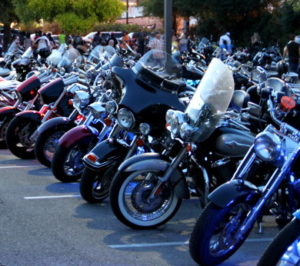 ogether for bonding, camaraderie, music and fun — there is one inevitability: There will be traffic accidents. The second day of the four-day event has resulted in six incidents so far, resulting in eight patients, according to Austin-Travis County EMS medics who keep a running tally of ROT-rally-originated emergencies each year of the congregation. Of those eight patients so far, seven required transport to the hospital, medics said.
ogether for bonding, camaraderie, music and fun — there is one inevitability: There will be traffic accidents. The second day of the four-day event has resulted in six incidents so far, resulting in eight patients, according to Austin-Travis County EMS medics who keep a running tally of ROT-rally-originated emergencies each year of the congregation. Of those eight patients so far, seven required transport to the hospital, medics said.
Bike crashes down, but cyclists still face dangers on Austin roads
Jojo McKibben, 36, suffered a traumatic brain injury, a lacerated liver and multiple fractures throughout her body in June when a 24-year-old motorist — who was later charged with driving while intoxicated — blew through a red light at the intersection at Lamar Boulevard and West Sixth Street, police said. The driver’s SUV hit a van, spun out of control and crashed into McKibben on her bicycle, pinning her beneath the SUV. Three police officers and four civilians had to lift the 3,400-pound vehicle off of McKibben to save her, an act of heroism that was later honored by the Austin Police Department.

Cyclist Jojo McKibben attended an awards ceremony at Austin police headquarters for her rescuers, who lifted a 3,400-pound vehicle off her chest and probably saved her life. 2017 AMERICAN-STATESMAN
On Tuesday, McKibben was struck again while riding her bike at Congress Avenue and Lightsey Road. This time she was sent to the hospital with several broken fingers, court documents detailing the crash show. The driver who hit her, identified as 58-year-old Richard Garcia Lopez, fled and was later arrested, police said. “Jojo’s injuries were minor, and we are grateful for this,” McKibben’s partner, Brendan Sharpe, said Wednesday. He did not want to talk further about the crash but urged riders to “be safe out there.”
Data compiled by Austin-Travis County Emergency Medical Services last year show a 60.5 percent decline in bike crashes in the past five years, from 557 in 2012 to 220 in 2017. These figures include crashes with motor vehicles, motorcycles and pedestrians as well as bike-only incidents, with most occurring in the city’s congested central corridor. Texas Department of Transportation data that look specifically at vehicle vs. bike crashes show less of a drop-off during that time, with 345 crashes in 2012 and 312 in 2017.
Jay Crossley with the city’s Vision Zero task force says bike ridership has increased in that time in Austin but that has not resulted in more crashes. Serious and incapacitating bike crashes are rare, with 12 deaths reported in the past five years, according to TxDOT figures. Nic Moe, the former board chair with Vision Zero, said these crashes tend to occur on the outskirts of the city, where people are driving fast and don’t expect to encounter cyclists, rather than in the central core.
“They don’t really happen downtown,” Moe said. “The infrastructure is pretty darn good, and people that are driving tend to anticipate that there will be cyclists.” The Austin Transportation Department has increased the number of bike lanes in the city over the past several years since adopting its 2014 Austin Bicycle Plan aimed at getting more people on bikes. Despite the drop in reported accidents, an attorney who represents primarily cyclists, Brad Houston, said he hasn’t seen his business slow down. He said Austin’s growth and increased traffic have caused more problems for riders. “I really don’t think it’s getting safer in Austin. That’s just contrary to what I see,” Houston said. “Bike lanes are good. They have a positive impact on safety, and they are a big help. But they don’t make it safe. Drivers just need to look in all directions. The problem is people need to be in the moment when they’re driving.” Houston would like to see stiffer legal consequences for motorists who hit cyclists. “When they are going easy on these bicycle cases, they are doing nothing to change the situation,” he said.
The driver who hit McKibben last year, Katie Bykowski, was indicted on a charge of intoxication assault, a third-degree felony punishable by up to 10 years in prison. She remains out of jail on a personal recognizance bond, and no scheduled hearings are listed in court records. McKibben also sued the Driskill Hotel and Star Bar, accusing them of over-serving Bykowski the night of the crash. The suit is awaiting a ruling in the criminal case, attorneys for McKibben said. Lopez, the driver accused of hitting McKibben on Tuesday, was arrested and remained in the Travis County Jail on Friday on a charge of accident involving serious bodily injury. His bail was set at $7,500, records show.
By Mary Huber – American-Statesman Staff
Auto-Pedestrain Collisions remain a problem for Austin
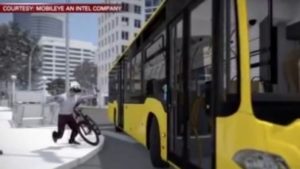 May 14, 2018 – AUSTIN, Texas – On board cameras from a CapMetro bus show how quickly an auto-pedestrian collision can happen. In a video, obtained by FOX 7 a construction worker can be seen trying to cross the road by darting between parked cars. He takes a a hard hit but the man survives. Its an example of a problem that Austin Police haven’t been able to stop. “Its extremely disappointing, we are out there working hard to try to make a difference, and we just don’t see the results we like to see,” said APD Detective Patrick Oborski.
May 14, 2018 – AUSTIN, Texas – On board cameras from a CapMetro bus show how quickly an auto-pedestrian collision can happen. In a video, obtained by FOX 7 a construction worker can be seen trying to cross the road by darting between parked cars. He takes a a hard hit but the man survives. Its an example of a problem that Austin Police haven’t been able to stop. “Its extremely disappointing, we are out there working hard to try to make a difference, and we just don’t see the results we like to see,” said APD Detective Patrick Oborski.
“It kind of goes back to what your parents brought you up and said, don’t make poor decisions, think about what you do before you do something. You are always suppose to look twice before you cross the road,” said Oborski. Unfortunately, not everyone remembers that safety rule there are those who ignore it and those who are guilty of whats called distracted walking. CapMetro provided FOX 7 with video clips of nearly 2 dozen incidents that have happened since 2016. Some defy explanation. There are joggers who run into buses. People who thrown themselves into buses and others who slide down the side trying to stop a bus. “Just a lot of really distorted people,” said Darrell Jamail, CapMetro’s security director. The bus cameras provide a glimpse of what every driver in Austin is facing.
“I think its a combination of things, just based on what we’ve seen over the years, the increase in congestion, the increase of traffic and pedestrian traffic on the roads and crossing the roads as well as the increase in use of electronic devices that people are paying sometimes more attention to those than their surroundings,” said Jamail.
There have been 8 Auto-Ped fatalities in Austin this year. One remains under investigation the other 7, according to investigators, were the fault of the pedestrian. There were more than 2100 auto pedestrian collisions in Austin between 2013 and 2017. One hundred and eighteen were fatalities, 1,899 involved injuries.
“All these, are cases that can be easily preventable,” said Detective Oborski. Risky runs and fatal collisions that took place on I-35- prompted a new response protocol by APD. “We are dispatching officers in what we call a code 3 incident, its a hot shot call meaning running lights a sirens to that person, trying to get to them before they make that decision to cross the roadway, so it is a priority one call for us,” said Oborski. A few safety enforcement initiatives have been tried. TxDOT handed out reflective gear to Austins’ transient community. Police also issued citations to drivers not yielding to people in cross walks. Those efforts only provided mixed results- but there is something new that may make a difference. Collision avoidance sensors. Mobileye an Intel Company is one of the companies offering a solution. Multiple sensors can be installed to cover blind spots.
Alerts go off if there is a risk of a collision with a vehicle, pedestrian or cyclist. There are Mobileye devices on a little more than 100 CapMetro buses. But the sensors that were installed only have a forward looking capability. “Is great equipment, but ultimately you don’t want to lull the driver or operators into a sense of security that it will take care of everything for them. Ultimately its on the driver of the vehicle, that they are doing their job,” said Jamail.
The best prevention, remains with the Pedestrian. Because failing to stop and look, can all too quickly look like one of the crashes caught on camera.
Texas ranks 8th for highest number of fatal DUI wrecks in the country
May 10, 2018 – FOX News7 — The Austin Police Department says there are 5,000 to 6,000 DWI arrests each year in Austin. They say their goal isn’t to increase this number, it’s actually to stop folks from driving under the influence altogether. This isn’t a new initiative. No Refusal has been happening every weekend this year so far in Austin, and it’s something APD attributes for bringing down the number of fatalities caused by intoxication in Austin. APD agrees. Here are the fatalty numbers attributed to intoxication in Austin.
In 2016 – there were 30 deaths.
In 2017 – there were 24.
Detective Michael Jennings with APD’s DWI Unit says another rising drug driving. Folks being under the influence of drugs while driving, which is also an offense. Even if it’s prescribed to you. Detective Jennings says Austin’s fatalities caused by intoxication needs to be zero, something his task force tries to achieve year round. “I think a lot of times people aren’t making a conscious decision saying they’ll go out and hurt or kill somebody that’s not what it is. But I think they make bad decisions of getting in the car.”
March 26, 2018 – AUSTIN – KVUETV — In a study published earlier this year, SleepJunkie.com analyzed data from the Centers for Disease Control, the National Highway Traffic Safety Administration and more to look at instances of drowsy driving crashes in the U.S. and the fatalities that had occurred from them.
Among their findings:
– Texas led the country in sleep-related fatalities in 2016. 159 were recorded in the Lone Star State compared to the next highest, Alabama, which had 43.
– The CDC claims that 1 in 25 drivers have fallen asleep while driving in the past month alone. Adding on their site that the NHTSA estimates nearly 72,000 crashes due to drowsy driving in 2016.
– While vehicle-on-vehicle crashes make up more than 30 percent of sleep-related crashes, nearly two-thirds of the crashes were from a vehicle running into another object.
SleepJunkie also found that Sundays and Mondays were statistically the worst days for sleep-related crashes and that the most crashes happened between 5 a.m. and 6 a.m. Experts urge sleepy drivers to always seek a safe way off the road and to then take a nap. In Texas, it is legal to spend up to 24 hours at a rest stop or rest area for napping purposes.
Statewide texting and driving ban may not go far enough
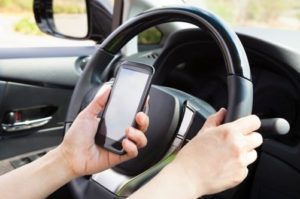 March 5, 2018 – AUSTIN (KXAN) — In the first four months since Texas implemented its statewide texting-while-driving law, the Texas Department of Public Safety reports it issued only 15 violations in Travis County — 14 warnings and a single citation. The new law is aimed at cutting down crashes in the state because one in five in Texas are caused by distracted driving. But advocates for the bill say the state law doesn’t go far enough to prevent fatal crashes.
March 5, 2018 – AUSTIN (KXAN) — In the first four months since Texas implemented its statewide texting-while-driving law, the Texas Department of Public Safety reports it issued only 15 violations in Travis County — 14 warnings and a single citation. The new law is aimed at cutting down crashes in the state because one in five in Texas are caused by distracted driving. But advocates for the bill say the state law doesn’t go far enough to prevent fatal crashes.
“The passage of the no texting state law is great. I’m glad they did it. I’m glad there is the awareness that there are dangers when you are texting while driving, but we now need to go to the next step,” said Mike Myers, whose daughter died when she was texting while driving back to Austin from Texas Tech University where she was going to school. “The night before, she called me and told me of all the things that she was looking forward to doing in her life and she was so excited… and then she was dead,” her father said. “We really do need to take it to the next step and ban the use of hand-held phones while driving.”
The city of Austin’s hands-free ordinance went into effect Jan. 1, 2015. “You can’t have a device in your hand whatsoever while you’re driving. You can’t use it for GPS. You can’t use it for Facebook,” explained Detective Patrick Oborski with the Austin Police Department. From Sept. 1 to Dec. 31, 2017, the city of Austin issued 2,841 citations for the offense. During that same time, DPS issued 1,474 total violations for texting and driving across the entire state.
“It’s not to write citations. It’s not to give you a fine. It’s for the safety, and it’s not anything else but the safety,” added Det. Oborski. “Even one fatality is too much here in the city, so if we can do anything at all to keep people’s eyes on the road and keep them more focused on what they’re doing… that’s our goal.” Violation of the city’s ordinance is a Class C Misdemeanor, punishable by a fine of up to $500. As the state’s texting ban went into effect Sept. 1, so did a required course to combat distracted driving before getting your license in Texas. It is called Impact Texas Young Drivers. All applicants 18 and older must complete the course — which is free — before taking their driving skills exam. There’s already a similar course for drivers ages 16 and 17.
Gov. Greg Abbott signed House Bill 62 into law in June after the ban passed the Texas Senate on May 19, 2017 in a 23-8 vote. The Texas House cleared the bill in an 111-62 vote in March last year. The bill was authored by State Rep. Tom Craddick, R-Midland, and State Sen. Judith Zaffrini, D-Laredo. Craddick said in a statement the governor is saving lives by deterring dangerous and deadly behavior.
“For a long time, Texas has needed this law to prevent the loss of life in unnecessary and preventable crashes and we finally have it,” Craddick continued. “This delivers a strong message to Texas drivers to stop texting, put down their phone, and keep their eyes on the road. Like AT&T says: It can wait.” This was the fourth time Texas lawmakers had tried to pass a texting-while-driving ban statewide. Gov. Abbott, dissatisfied with the law as currently written, said he wants the measure to override city ordinances so there isn’t a “patchwork quilt” of distracted driving laws across the state. If legislators do not get to it during the special session, the ban as it is currently written will still move forward and become law in September.
Read the full bill on the state of Texas’ website.
For more information about Vision Zero ATX, click here.
Austin traffic deaths down in 2017 in 2nd consecutive yearly drop

According to Austin police, a blue Chevrolet Sonic heading north on Cameron Road was hit by a blue Chevrolet pickup traveling west on the frontage road of U.S. 290 in Northeast Austin on March 30. A passenger in the Sonic, 85-year-old Elizabeth Durst, died after being taken to the hospital. RICARDO B. BRAZZIELL/AMERICAN-STATESMAN
Goldstein became the 76th and last person to die on Austin roads last year, but the number of traffic deaths in 2017 fell for the second consecutive year, from 79 in 2016, following a record-setting spike in 2015, when 102 people died. Although several of the crashes in 2017 had multiple victims, the total number of deadly crashes also dropped from 2016. Police investigated 71 fatal incidents in 2017, a nearly 8 percent decrease from 77 in 2016. Assistant Police Chief Troy Gay told members of the city’s Public Safety Commission on Monday that crashes overall were also down roughly 7 percent in 2017.
Police records show that fatal crashes involving pedestrians, motorcycles and motor vehicles all were down last year, but more bicyclists were killed:
• Twenty-three pedestrians died in 2017, compared with 28 in 2016.
• Eleven fatal crashes involved motorcycles in 2017, compared with 13 in 2016.
• Four bicyclists were killed in 2017, compared with two in 2016.
The numbers for 2017 were more in line with those recorded before an unprecedented rise in 2015 in which 102 people died on Austin roads. Austin police counted 78 deaths in 2012, 75 in 2013 and 63 in 2014. Before that, Austin traffic deaths were even lower. The average number of deadly crashes from 2007 through 2011 was 57, with the lowest being 49 in 2010 and the highest 62 in 2009. At least 35 of the 71 crashes in 2017 were believed to have involved an intoxicated person.
Francis Reilly, program manager for Vision Zero, a task force working to eliminate Austin traffic deaths by 2025, said that while a reduction in deaths is promising, it’s hard to say whether it is indicative of something more significant. “Looking at crashes over the long term, there’s a lot of fluctuation in those numbers, so it’s hard to look at just one or even two years and say that we have a trend necessarily,” Reilly said. Vision Zero examines crashes and tries to devise data-guided strategies and solutions through engineering, law enforcement, education and policies. “We’re taking a longer-term view of this, certainly,” Reilly said. “It’s keeping in mind that these aren’t just numbers; these are people with families and loved ones who are dying on our roads.”
Jen Samp, a spokeswoman for Vision Zero, said authorities have worked hard to pinpoint specific danger spots, such as the intersections of Martin Luther King Jr. Boulevard and Interstate 35, North Lamar Boulevard and Parmer Lane, and Cameron Road and U.S. 183, as well as North Lamar between Rutland Drive and Rundberg Lane. Improvements completed in 2016 and 2017 contributed to significant reductions in crashes at those intersections, city Transportation Department officials said. At MLK and I-35, crashes were reduced 61 percent after the city added a southbound through lane, a right-turn island and raised crosswalks, among other improvements.
Crashes fell 57 percent at U.S. 183 and Cameron Road after the addition of a right-turn pedestrian refuge island, high-visibility continental crosswalks and an advance warning flasher on the eastbound frontage road of U.S. 183. Those improvements were completed in 2016.
In 2017, similar improvements contributed to a 22 percent decrease in crashes on Lamar between Rutland and Rundberg and a 43 percent decrease at Lamar and Parmer, city records show. She said authorities also have pushed for education and enforcement to curb some of the behaviors that lead to deadly crashes, such as driver inattention and distraction, speed, alcohol or drugs, improper movements, failure to stop, and failure to yield the right of way. Austin police officers posted on city buses have caught and ticketed people who use their phones while driving. In 2017, the department issued 10,446 citations for driving while using an electronic device.
Officers also targeted drunken drivers by expanding no-refusal periods to cover more weekends in 2017. During no-refusal weekends, officers have more legal resources to obtain blood alcohol samples from suspected drunken drivers who refuse to be tested. The department said crashes in which drivers were intoxicated fell 22 percent in 2017, and no-refusal efforts will remain the same in 2018. “The main goal is behavior change — whether it be enforcement doing it, engineering doing it or education doing it,” Samp said. “Whether it’s one or the other. We are going to try all of them.”
By Mark Wilson – American-Statesman Staff
Task force plans to eliminate Austin traffic deaths by 2025
May, 2016 – AUSTIN (KXAN) — Last year marked the deadliest days on Austin roadways. Now a plan is moving forward to ensure 2016 doesn’t have as many traffic deaths. So far, 14 people have died on Austin roads. Groups are working to keep the number of deaths below 100 people, which is the number killed in 2015 crashes. The goal is to eliminate traffic deaths by 2025.
The Vision Zero Task Force is releasing their finalized plans to the Austin Public Safety Commission on Monday. They are looking at crash data from 2010 to 2014, to locate the underlying patterns behind deadly and serious crashes. The cause of many crashes includes speed, distractions, intoxication and failing to stop. One of the recommendations is to immediately impound vehicle for drivers who are caught driving without a valid license.
Last year the city compiled a list of intersections that need safety improvements. The cost of fixing all five intersections would be around $4 million.
- Lamar Boulevard and Parmer Lane (North Austin)
- Lamar Boulevard and Rundberg Lane (North Austin)
- U.S. 183 Service Road and Cameron Road (Northeast Austin)
- I-35 and Martin Luther King Jr. Boulevard (near Downtown)
- West Slaughter Lane and Manchaca Road (South Austin)
An audit of the City of Austin in April revealed that crash information was not utilized to improve public safety. The audit stated, “not all crash information is being systematically analyzed which could identify targeted engineering, enforcement, or educational solutions to address safety and traffic flow challenges.”
Austin Joins Vision Zero Program To End Traffic Fatalities
Austin Mayor Steve Adler hopes the national program will help reverse that deadly trend. In a statement, the mayor said, “By sharing ideas and lessons with other cities committed to Vision Zero, we can move the needle on public safety across the nation. Great cities do big things, and participating in the Vision Zero Focus Cities program will help us accomplish our goal.”

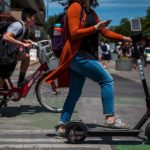 Dec. 7, 2018 – By Paul Cobler – Statesman.com —
Dec. 7, 2018 – By Paul Cobler – Statesman.com — 
